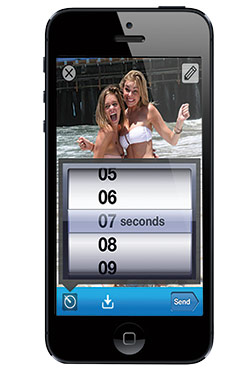
The future of photography is impermanent, report the students of Staples High School in Westport, Connecticut. Last May, they started using Snapchat, a wickedly simple new app for the iPhone that allows the user to take a photo, scribble or type on it, and then send it to a friend. The app caught on with bubonic speed owing to one ingenious feature: After a few seconds, the message vanishes, like a communiqué in Mission: Impossible.
When people, especially parents, first hear about this disappearing-ink trick, they assume it has only one purpose: sexting. But the students who use it know that its true purpose lies in a different clunky neologism: taking self-portraits, called selfies. More specifically, really ugly selfies.
The photos these students send—up to 35 a day, according to one—are almost always of faces, and almost always comically unflattering: A young man’s face, with clamped lips, and beneath it the words Es cold; another, from a young woman, lips in a rictus of fear; a third, from a guy wearing a hat shaped like a T. rex head, with a message reading, “I’m a Dino!” For kids more conscious than any generation before them of their faces’ various angles and how they might be rendered alien and grotesque onscreen, the chance to look ugly and not worry that it might end up haunting them on the Internet is actually revelatory. Of course, there are occasional indiscretions. One senior girl, Allie, remembers receiving a picture of a female friend, naked, with her privates scribbled over. (It was a joke.) A senior guy, who is openly gay, once received a nude photo from another male student, who is not openly gay. (Not a joke.) He glanced at it, but then in a heartbeat it was gone. “It doesn’t actually make sense for sexting,” points out Snapchat’s 22-year-old co-founder and CEO, Evan Spiegel, three credits shy of graduating from Stanford. “Because you see the photo for, what, three seconds?”
Spiegel’s larger hope for the app is that it’ll allow people to share photos without feeling like they’re curating their own “super-boring” permanent records. “It’s, ‘Here’s this nice dinner I went to.’ Or ‘Here’s my prom photos,’ ” he says. “Hopefully, we’ll get away from this false nostalgia about sushi dinners and more into ‘Hey, here’s what I’m doing right now.’ ”
Snapchat is currently sharing more than 10 million images a day, but already some students at Staples say they are growing sick of the app—people are overusing it, flooding other kids’ phones. And many were recently distressed to discover that it was possible to capture screen shots of received photos. (When a screen shot is taken, the sender gets an alert, but then what? Hostage negotiations?) Already, says a junior named Kelly, students have begun sending less ugly and, hence, less funny, photos. Another junior named Will, who claims he introduced the app to the school, is now considering quitting it altogether. That would be unimaginable with Facebook, because he’s still stuck using it for “substantive things” like drama-rehearsal schedules and school announcements. “That’s the beauty of Snapchat,” he says. “There’s nothing substantive on it, ever.”
Have good intel? Send tips to intel@nymag.com.